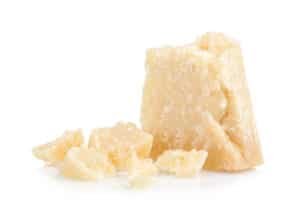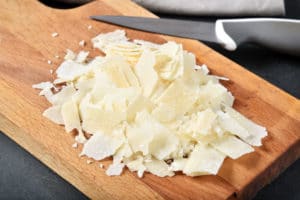By Anne Palumbo
 From nutritionists to cheese connoisseurs to sports trainers, parmesan cheese is favored by many and here’s why: It promotes bone health; it’s virtually lactose-free; it rocks with complete protein; and it’s loaded with flavor.
From nutritionists to cheese connoisseurs to sports trainers, parmesan cheese is favored by many and here’s why: It promotes bone health; it’s virtually lactose-free; it rocks with complete protein; and it’s loaded with flavor.
True parmesan cheese (officially called Parmigiano-Reggiano) is a hard Italian cheese with a gritty texture and a complex fruity-nutty taste. Many artisanal and large cheese producers here in the U.S. also make decent parmesan.
What makes this cheese stand alone (no matter its origin) is its lengthy aging process — a process that results in unique nutritional benefits.
Time spent in the cellar cooling system helps protein develop, causing parmesan to have a higher percentage of this valuable nutrient compared with most cheeses. Thanks to its long aging, parmesan’s protein is easily digested, making it a good choice for infants and toddlers, seniors and others with delicate digestive systems. Likewise, this ready protein is favored as a quick energy source for marathon runners and weekend athletes alike.
Parmesan contains virtually no lactose, which is deliriously good news for those who are lactose-intolerant. Once again, parmesan’s lengthy ripening process contributes to this welcome benefit.
 Bones and teeth appreciate parmesan because it’s a decent source of two essential minerals: calcium and phosphorous. An ounce of this nutrient-dense cheese (roughly the size of your thumb) delivers about a third of your daily needs for calcium and a fourth for phosphorous. Both minerals help to keep bones and teeth healthy and strong. Interestingly, studies have suggested that eating harder cheeses like parmesan as the final food in your meal will help to reduce cavities. Chewing cheese stimulates saliva flow, which helps neutralize the acids that break down enamel.
Bones and teeth appreciate parmesan because it’s a decent source of two essential minerals: calcium and phosphorous. An ounce of this nutrient-dense cheese (roughly the size of your thumb) delivers about a third of your daily needs for calcium and a fourth for phosphorous. Both minerals help to keep bones and teeth healthy and strong. Interestingly, studies have suggested that eating harder cheeses like parmesan as the final food in your meal will help to reduce cavities. Chewing cheese stimulates saliva flow, which helps neutralize the acids that break down enamel.
One heaping tablespoon of shredded parmesan has around 22 calories and 1.5 grams of total fat, most of which is saturated fat. Since saturated fat raises blood cholesterol levels, which may then increase your risk of heart disease and stroke, the American Heart Association recommends no more than about 13 grams a day. The good news is, parmesan’s intense flavor steers us toward moderation.
Chicken Caesar Salad with Grated Parmesan
Serves 4
For Salad:
3-4 skinless, boneless chicken breasts
3 romaine lettuce hearts, washed and torn into bite-size pieces
½ cup or more shredded parmesan cheese
For Dressing:
2 garlic cloves, minced
½ teaspoon Worcestershire sauce
2 tablespoons fresh lemon juice
2 teaspoons balsamic vinegar
2 teaspoons mayonnaise
1½ teaspoons Dijon mustard
½ teaspoon salt
¼ teaspoon coarse black pepper
1 teaspoon anchovy paste (optional)
4 tablespoons olive oil
Preheat grill to medium high. Salt and pepper chicken breasts. Grill for about 10-12 minutes, flipping at the halfway point (meat is done when thickest part registers 165 degrees). Let cool; slice crosswise into strips.
Make dressing: In a small bowl, whisk everything together but the olive oil. Slowly whisk in the olive oil until well blended.
Assemble salad: In a large bowl toss together lettuce and half of the parmesan. Drizzle with desired amount of dressing and toss again. Plate, top with several slices of grilled chicken, and sprinkle each portion with remaining parmesan.
Helpful tips
If you’re after authentic Italian parmesan look for the branding on the rind: Parmigiano-Reggiano or Grana Padano. For best flavor, buy a wedge from a wheel rather than pre-grated cheese. If buying pre-grated parmesan, look for American producers with good reputations, such as Sartori and BelGioioso. Store leftover cheese in a small zipper-lock bag and squeeze out as much air as possible before fastening seal.
Anne Palumbo is a lifestyle columnist, food guru, and seasoned cook, who has perfected the art of preparing nutritious, calorie-conscious dishes. She is hungry for your questions and comments about SmartBites, so be in touch with Anne at avpalumbo@aol.com.

